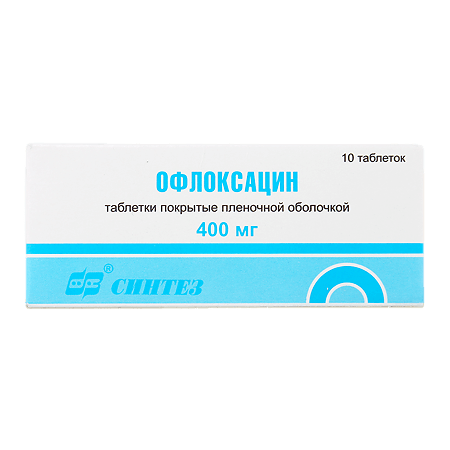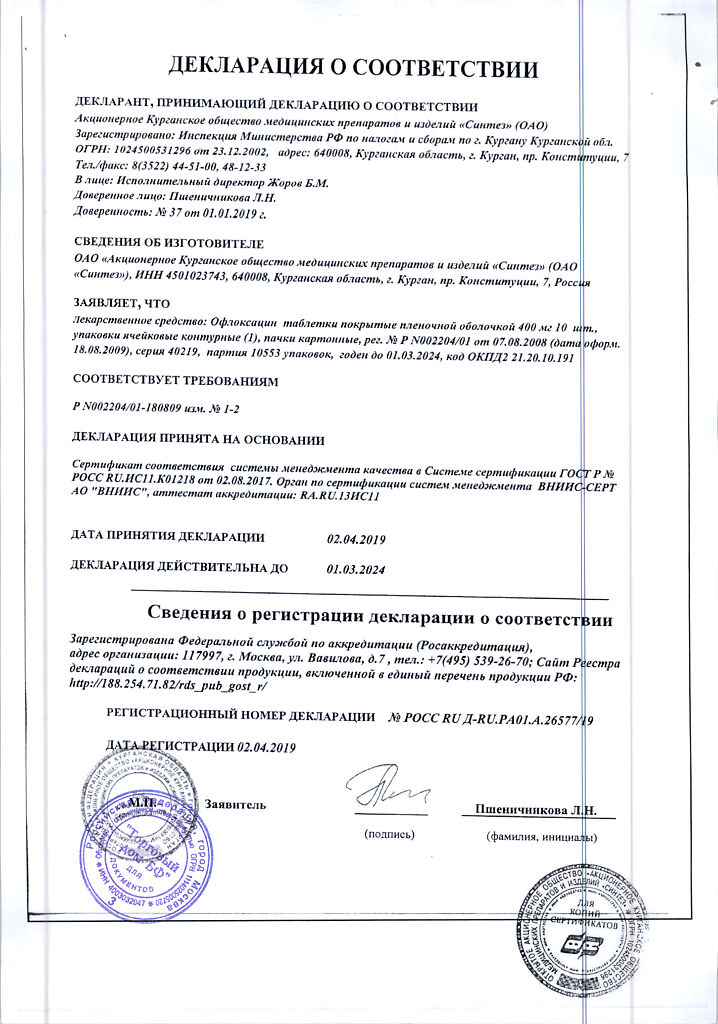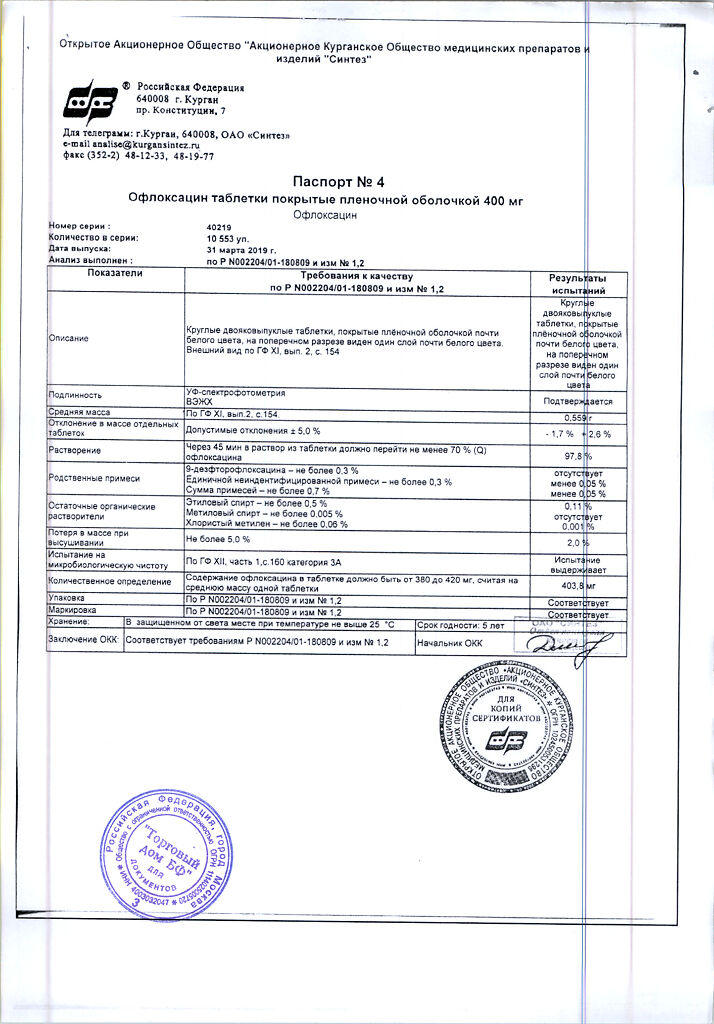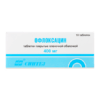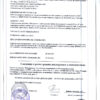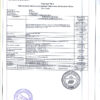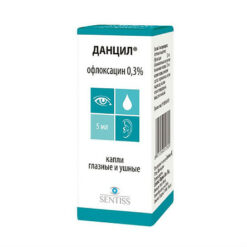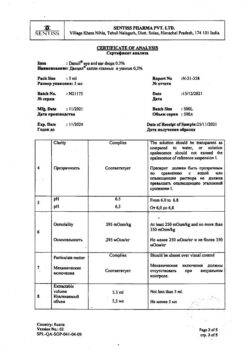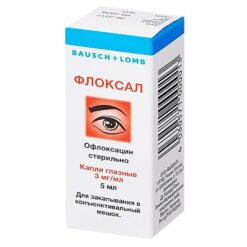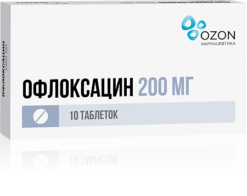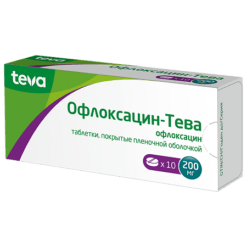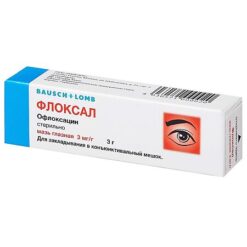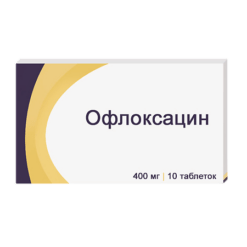No products in the cart.
Ofloxacin, 400 mg 10 pcs
€1.56 €1.00
Out of stock
(E-mail when Stock is available)
Description
A broad-spectrum antimicrobial agent of the group of fluoroquinolones. It acts on the bacterial enzyme DNA-hyraza, which provides superspiralization and thus stability of bacterial DNA (destabilization of DNA chains leads to their death). It has a bactericidal effect.
The drug is active against β-lactamase-producing microorganisms and fast-growing atypical mycobacteria.
The following are sensitive to the drug: Staphylococcus aureus, Staphylococcus epidermidis, Neisseria gonorrhoeae, Neisseria meningitidis, Escherichia coli, Citrobacter spp, Klebsiella spp. (including Klebsiella pneumoniae), Enterobacter spp., Hafnia spp., Proteus spp. (including Proteus mirabilis, Proteus vulgaris – indole positive and indole negative strains), Salmonella spp, Shigella spp. (including Shigella sonnei), Yersinia enterocolitica, Campylobacter jejuni, Aeromonas hydrophila, Plesiomonas aeruginosa, Vibrio cholerae, Vibrio parahaemolyticus, Haemophilus influenzae, Chlamydia spp, Legionella spp., Serratia spp., Providencia spp., Haemophilus ducreyi, Bordetella parapertussis, Bordetella pertussis, Moraxella catarrhalis, Propionibacterium acnes, Brucella spp.
Different sensitivities to the drug have: Enterococcus faecalis, Streptococcus pyogenes, Streptococcus pneumoniae, Streptococcus viridans, Serratia marcescens, Pseudomonas aeruginosa, Acinetobacter spp, Mycoplasma hominis, Mycoplasma pneumoniae, Mycobacterium tuberculosis, Mycobacteriurn fortuitum, Ureaplasma urealyticum, Clostridium perfringens, Corynebacterium spp., Helicobacter pylori, Listeria monocytogenes, Gardnerella vaginalis.
The drug is resistant to Nocardia asteroides, anaerobic bacteria (Bacteroides spp., Peptococcus spp., Peptostreptococcus spp., Eubacterium spp., Fusobacterium spp., Clostridium difficile).
The drug is inactive against Treponema pallidum.
Indications
Indications
infectious and inflammatory diseases of the respiratory tract (bronchitis, pneumonia);
infectious and inflammatory diseases of the ENT organs (sinusitis, pharyngitis, otitis media, laryngitis);
infectious and inflammatory diseases of the skin and soft tissues;
infectious and inflammatory diseases of bones and joints;
infectious and inflammatory diseases of the abdominal cavity (including infections of the gastrointestinal tract) and biliary tract;
infectious and inflammatory diseases of the kidneys (pyelonephritis) and urinary tract (cystitis, urethritis);
infectious and inflammatory diseases of the pelvic organs (endometritis, salpingitis, oophoritis, cervicitis, parametritis, prostatitis) and genital organs (colpitis, orchitis, epididymitis);
gonorrhea;
chlamydia;
meningitis;
prevention of infections in patients with impaired immune status (including neutropenia).
Pharmacological effect
Pharmacological effect
A broad-spectrum antimicrobial drug from the group of fluoroquinolones. Acts on the bacterial enzyme DNA gyrase, which ensures supercoiling and, thus, stability of bacterial DNA (destabilization of DNA chains leads to their death). Has a bactericidal effect.
The drug is active against microorganisms that produce β-lactamases and fast-growing atypical mycobacteria.
The following are sensitive to the drug: Staphylococcus aureus, Staphylococcus epidermidis, Neisseria gonorrhoeae, Neisseria meningitidis, Escherichia coli, Citrobacter spp., Klebsiella spp. (including Klebsiella pneumoniae), Enterobacter spp., Hafnia spp., Proteus spp. (including Proteus mirabilis, Proteus vulgaris – indole-positive and indole-negative strains), Salmonella spp., Shigella spp. (including Shigella sonnei), Yersinia enterocolitica, Campylobacter jejuni, Aeromonas hydrophila, Plesiomonas aeruginosa, Vibrio cholerae, Vibrio parahaemolyticus, Haemophilus influenzae, Chlamydia spp., Legionella spp., Serratia spp., Providencia spp., Haemophilus ducreyi, Bordetella parapertussis, Bordetella pertussis, Moraxella catarrhalis, Propionibacterium acnes, Brucella spp.
The following have varying sensitivity to the drug: Enterococcus faecalis, Streptococcus pyogenes, Streptococcus pneumoniae, Streptococcus viridans, Serrratia marcescens, Pseudomonas aeruginosa, Acinetobacter spp., Mycoplasma hominis, Mycoplasma pneumoniae, Mycobacterium tuberculosis, Mycobacteriurn fortuitum, Ureaplasma urealyticum, Clostridium perfringens, Corynebacterium spp., Helicobacter pylori, Listeria monocytogenes, Gardnerella vaginalis.
Nocardia asteroides, anaerobic bacteria (Bacteroides spp., Peptococcus spp., Peptostreptococcus spp., Eubacterium spp., Fusobacterium spp., Clostridium difficile) are resistant to the drug.
The drug is inactive against Treponema pallidum.
Special instructions
Special instructions
It is not a drug of choice for the treatment of pneumonia caused by pneumococci, and is not indicated for the treatment of acute tonsillitis.
During the treatment period, it is necessary to refrain from driving vehicles and engaging in potentially hazardous activities that require increased concentration and speed of psychomotor reactions. You can’t drink alcohol.
During treatment with the drug, you should not use hygienic tampons like Tampax, due to the increased risk of developing thrush.
During treatment, the course of myasthenia gravis may worsen and attacks of porphyria may increase in predisposed patients.
False-negative results are possible in the bacteriological diagnosis of tuberculosis (prevents the isolation of Mycobacterium tuberculosis).
Active ingredient
Active ingredient
Ofloxacin
Composition
Composition
Active substance:
ofloxacin – 400 mg;
Excipients:
corn or potato starch;
MCC;
talc;
low molecular weight polyvinylpyrrolidone;
magnesium or calcium stearate;
aerosil
Shell composition:
hydroxypropyl methylcellulose; talc; titanium dioxide; propylene glycol; polyethylene oxide 4000 or opadry II
Contraindications
Contraindications
deficiency of glucose-6-phosphate dehydrogenase;
epilepsy (including history);
decreased seizure threshold (including after traumatic brain injury, stroke or inflammatory processes in the central nervous system);
age up to 18 years (because skeletal growth is not complete);
pregnancy;
lactation (breastfeeding);
hypersensitivity to the components of the drug.
The drug should be prescribed with caution in case of atherosclerosis of cerebral vessels, cerebrovascular accidents (history), chronic renal failure, organic lesions of the central nervous system.
Side Effects
Side Effects
From the gastrointestinal tract: gastralgia, anorexia, nausea, vomiting, diarrhea, flatulence, abdominal pain, increased activity of liver transaminases, hyperbilirubinemia, cholestatic jaundice, pseudomembranous enterocolitis.
From the nervous system and sensory organs: headache, dizziness, uncertainty of movements, tremors, convulsions, numbness and paresthesia of the extremities, intense dreams, “nightmare” dreams, psychotic reactions, anxiety, state of excitation, phobias, depression, confusion, hallucinations, increased intracranial pressure; impaired color vision, diplopia, impaired taste, smell, hearing and balance. When using the ointment – a burning sensation and discomfort in the eyes, hyperemia, itching and dryness of the conjunctiva, photophobia, lacrimation.
From the musculoskeletal system: tendinitis, myalgia, arthralgia, tenosynovitis, tendon rupture.
From the cardiovascular system and blood (hematopoiesis, hemostasis): tachycardia, decrease in blood pressure (with intravenous administration; with a sharp decrease in blood pressure, the administration is stopped), vasculitis, collapse; leukopenia, agranulocytosis, anemia, thrombocytopenia, pancytopenia, hemolytic and aplastic anemia.
Allergic reactions: skin rash, itching, urticaria, allergic pneumonitis, allergic nephritis, eosinophilia, fever, Quincke’s edema, bronchospasm, Stevens-Johnson and Lyell syndrome, photosensitivity, erythema multiforme, rarely – anaphylactic shock.
From the skin: pinpoint hemorrhages (petechiae), bullous hemorrhagic dermatitis, papular rash with crust, indicating vascular damage (vasculitis).
From the genitourinary system: acute interstitial nephritis, impaired renal function, hypercreatininemia, increased urea content.
Other: dysbacteriosis, superinfection, hypoglycemia (in patients with diabetes), vaginitis.
Interaction
Interaction
Compatible with the following infusion solutions: isotonic sodium chloride solution, Ringer’s solution, 5% fructose solution, 5% dextrose (glucose) solution.
Do not mix with heparin (risk of precipitation).
Food products, antacids containing Al3+, Ca2+, Mg2+ or iron salts reduce the absorption of ofloxacin, forming insoluble complexes (the interval between doses of these drugs should be at least 2 hours).
Reduces the clearance of theophylline by 25% (with simultaneous use, the dose of theophylline should be reduced).
Cimetidine, furosemide, methotrexate and drugs that block tubular secretion increase the plasma concentration of ofloxacin.
Increases the concentration of glibenclamide in plasma.
When taken simultaneously with vitamin K antagonists, it is necessary to monitor the blood coagulation system.
When prescribed with NSAIDs, nitroimidazole and methylxanthine derivatives, the risk of developing neurotoxic effects increases.
When administered concomitantly with glucocorticoids, the risk of tendon rupture increases, especially in the elderly.
When prescribed with drugs that alkalinize urine (carbonic anhydrase inhibitors, sodium bicarbonate), the risk of crystalluria and nephrotic effects increases.
Overdose
Overdose
Symptoms: dizziness, confusion, lethargy, disorientation, drowsiness, vomiting.
Treatment: gastric lavage, symptomatic therapy.
Storage conditions
Storage conditions
List B. The drug should be stored in a dry place, protected from light, out of reach of children, at a temperature not exceeding 25°C.
Shelf life
Shelf life
2 years.
Manufacturer
Manufacturer
Sintez, Russia
Additional information
| Shelf life | 2 years. |
|---|---|
| Conditions of storage | List B. The drug should be stored in a dry place, protected from light, out of reach of children, at a temperature not exceeding 25 ° C. |
| Manufacturer | Sintez OAO, Russia |
| Medication form | pills |
| Brand | Sintez OAO |
Other forms…
Related products
Buy Ofloxacin, 400 mg 10 pcs with delivery to USA, UK, Europe and over 120 other countries.

